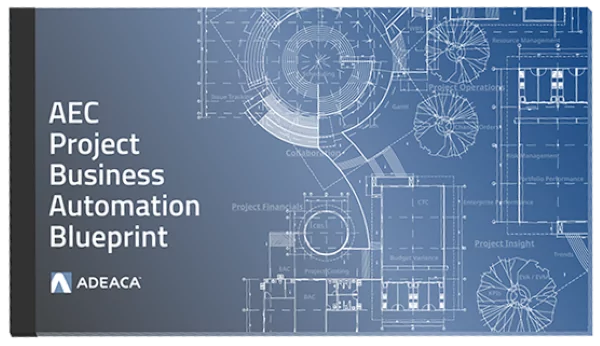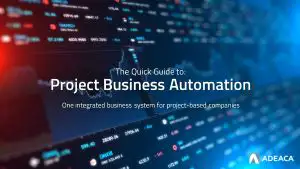Architecture, engineering and construction (AEC) companies should be able to run their business with real-time visibility and control just like other types of businesses in retail an manufacturing. Project Business Automation, now recognized by Forrester as a new category of business systems that support AEC companies from end-to-end, is designed to do just that.
PBA standardizes, integrates and systemizes all AEC processes and data. More specifically, PBA rejects the status quo of disparate, disconnected applications in favor of one integrated business system that automates and connects processes seamlessly in real time.
Download the AEC Project Business Automation Blueprint to learn how PBA creates a streamlined, comprehensive system for AEC companies.
The AEC Problem
Most AEC companies operate in silos of different departments and functions using different systems to support their needs. Oftentimes, AEC businesses employ 10 to 15 different systems and applications to manage their business processes. While they utilize this mix of applications, AEC companies still manage most of their information in spreadsheets.
As a result, many employ controllers and data processes to export, import and consolidate data from these different systems. They have to massage and manipulate this data to create reports for executives who are trying to manage the business and make important decisions with this information.
This disjointed fashion of operations results in two major problems:
Lack of Visibility: AEC business executives typically have very little visibility into the current status of their projects. At best, they may be receiving weekly status updates and monthly overviews, but by the time it gets to them, the information is already outdated. This is due to the fact that it takes time to consolidate the data and generate these reports. Consequently, many issues and risks go unnoticed until it is too late, causing bigger problems down the road.
It’s almost impossible for AEC executives to make effective decisions for their companies with unreliable, outdated information.
Lack of Control: Operating in a disparate application landscape means there is little control over the operations of the company. Since work and information flows are not connected, it’s difficult to standardize or insert a mechanism of control over such a landscape. This means that project and company performance as a whole depend strictly on the performance of individuals. That shouldn’t be the case.
Poor Performance: A lack of visibility and control means poor business performance. Small issues become big problems and ultimately, project timelines and budgets slip. The bottom line is AEC business performance suffers.
Project Business Automation: Deliver AEC Projects On Time and On Budget
There’s only one solution to address the non-integrated mode of operation in the AEC business: integrate. PBA does just that for AEC companies.
Project Financials: More than Project Accounting
The effective financial management of AEC projects requires much more than what traditional project accounting systems provide. PBA closes the gap between what AEC companies need and what mainstream ERP solutions offer.
While a solid accounting framework is required to track actual costs and invoices, revenue recognition, accruals and budgets, it’s not enough. When it comes to securing construction project profitability and supporting effective decision making, it’s much more important to track EAC, variances, profitability, contingencies and productivity while identifying trends and maintaining a full audit trail.
Project Operations: Go Beyond Project Management
AEC companies know how critical it is to be able to accurately plan engagements while managing resources, subcontractors, risks, deadlines and related supply chain activities. A lack of real-time insight into the delivery operations will result in increased risk and decreased profitability.
Project management applications were originally built to manage standalone projects. Keep in mind they are not meant to run your entire AEC business.
However, PBA for AEC offers a completely different approach to managing project operations. PBA provides complete and real-time integration between back-end ERP functions and your operational project management activities.
The project plan is the central entity against which a host of other operational activities are planned and managed such as: issue and deadline tracking, risk evaluation, staffing, capacity leveling and procurement/production schedules.
The key to operational excellence is scalable and predictable business processes. PBA for AEC allows all critical operational business processes to be executed within a single solution with built-in process control and audit capabilities. This enables companies to control process flows throughout the enterprise, establishing an enforceable and repeatable operational model.
Project Insight: Unprecedented Real-Time Intelligence
With PBA, AEC executives gain the real-time insight they need to transform their companies into high-performing enterprises. PBA gets the right information to the right people instantly. When all essential project functionality is brought into one system, AEC executives have access to project and business intelligence faster than ever before. This means they are able to make decisions with the most accurate and updated information available.
In addition, PBA for AEC provides the tools required to identify trends and benchmark your performance against company goals and industry standards. Since there is no data translation or time-lapse between source transactions and visualization, intelligence is available in real-time, allowing you to make timely and informed business decisions.
Benefits of PBA for AEC Companies
As a result of the improved business management that PBA provides, it delivers these clear business benefits for AEC firms:
Cost Control: Consistent visibility and standardized project costing tools eliminate guesswork. The instant integration of project financials and operations guarantees that all costs are always up to date. This results in stronger control over project costs and clearer forecasts so you can deliver more projects within budget.
Risk Readiness: PBA prepares your AEC business for risk by automatically monitoring your project and business KPIs in real time. The system flags deviations and trends so you have an in-depth view of potential problems allowing you to take mitigating action faster.
Deliverability: By optimizing capacity and managing internal and external constraints, PBA sets up your operations to deliver more projects on time. Managing the project schedule is core to PBA. Everything that affects the schedule is tied to it, systematically enabling you to meet client expectations, while maximizing the use of your revenue-producing resources.
Better Outcomes: With PBA, AEC companies can deliver more projects on time and on budget. It helps AEC firms produce better outcomes for their clients, ultimately leading to increased revenue and profitability.
Now more than ever, AEC companies are taking steps to embrace new technologies to make them more productive, sustainable and profitable. Project Business Automation is more than a solution, it’s a growing movement. More vendors are beginning to embrace this new category resulting in AEC companies adopting PBA and seeing transformative results.











